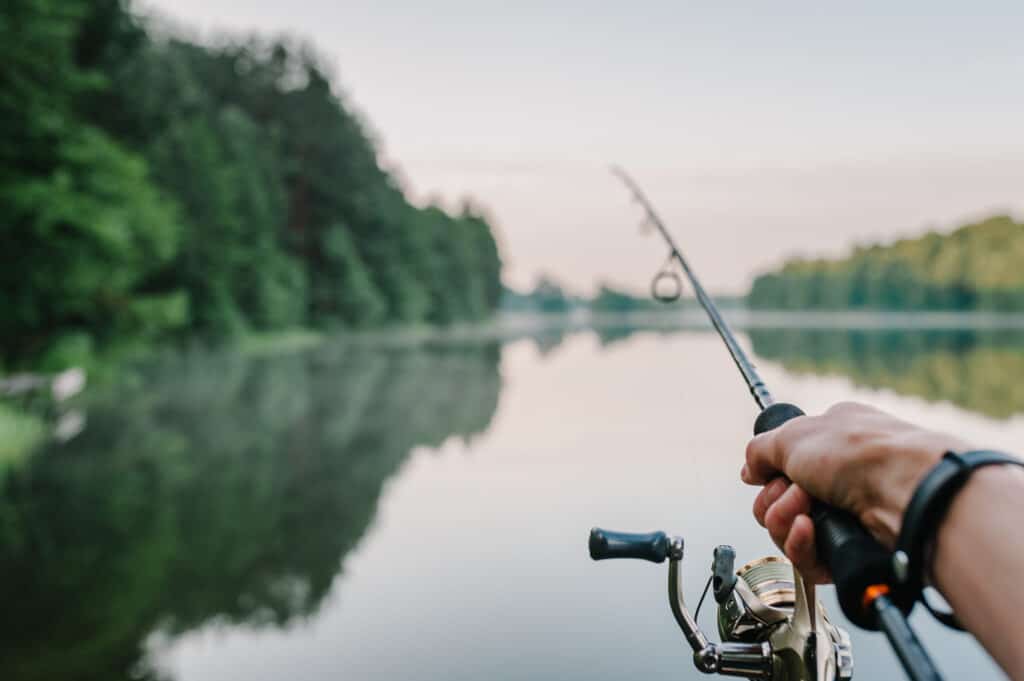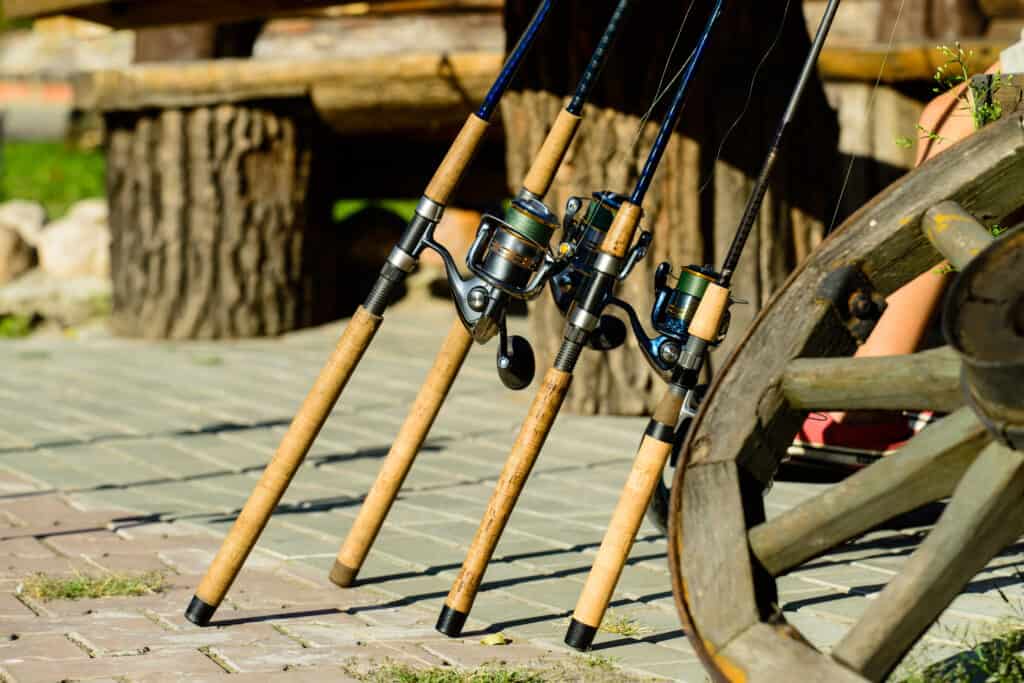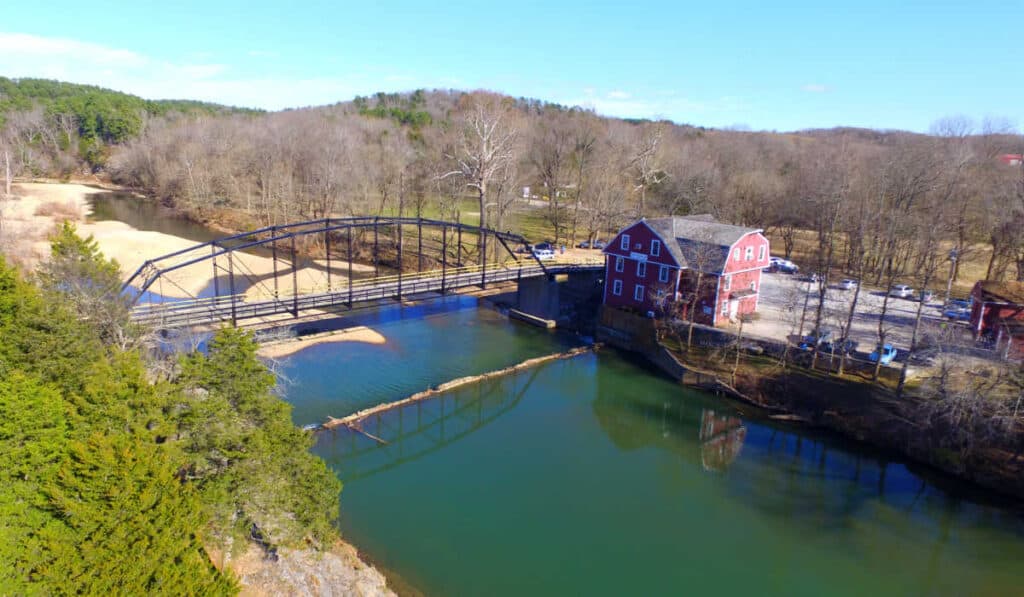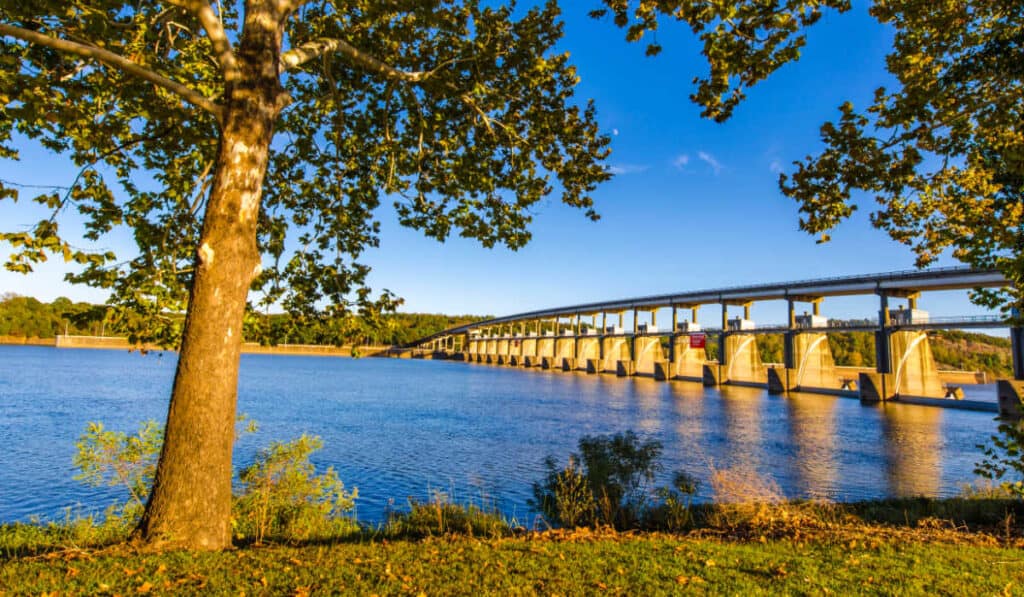Are you looking to explore the Lake of the Ozarks and catch some fish? Our Lake of the Ozarks fishing guide is here to provide you with all the information needed for a successful day on this incredible body of water. From knowing where to find your favorite species, what kind of gear works best in its waters, and even how conservation efforts are being made at Lake of the Ozarks – our comprehensive guide has it all.
With tips from experts who know these waters like their own backyard, we’ll help get you ready for an unforgettable experience out on one of America’s premier lakes. So grab your tackle box and let’s dive into everything there is to learn about fishing at Lake Of The Ozark.
Location of Lake of the Ozarks
The Lake of the Ozarks is located in central Missouri, just south of the city of St. Louis and north of Springfield. It is a large reservoir lake that was created by damming the Osage River in 1931. The lake spans over 54,000 acres and has more than 1,150 miles of shoreline.
Geographical Overview
The Lake of the Ozarks is situated on rolling hills with elevations ranging from 800 to 1,200 feet above sea level. The area surrounding the lake consists mainly of forests and farmland with some small towns scattered throughout. There are several state parks located around the lake that offer camping, hiking trails, fishing spots, swimming areas, and other recreational activities for visitors to enjoy.
Accessibility
Getting to Lake of the Ozarks can be done by car or plane depending on where you’re coming from. If driving from St Louis it takes about two hours while flying into nearby airports such as Branson Airport or Springfield-Branson National Airport will take less time but require additional transportation arrangements once you arrive at your destination airport.
Nearby Attractions
The Lake of the Ozarks is a great destination for outdoor recreation and fishing, offering easy access to a variety of attractions. With an array of fish species present in the lake, it’s time to explore what types of fish you can find.
Types of Fish in Lake of the Ozarks

Lake of the Ozarks is home to a wide variety of fish species, making it an ideal destination for anglers.
The most common species of fish in the lake include:
- Largemouth Bass
- Smallmouth Bass
- White Bass
- Black Crappie
- Bluegill
- Catfish (Flathead, Channel, and Blue)
- Walleye
- Hybrid Striped Bass
- Paddlefish
- Muskie
Rare species in Lake of the Ozarks include paddlefish, muskellunge (muskie), striped bass hybrids (wiper) and northern pikeminnow (squawfish). Paddlefish can be distinguished from other fish due to its long snout which resembles a duck bill or paddle shape hence its name “paddle” fish. Muskies are known for having sharp teeth similar to those found on sharks; they also have distinctively colored bodies ranging from greenish-brown to gold or even silver in some cases. Wipers look like hybrid between whitebass and striped bass; they typically grow up to 30 inches in length but can reach lengths of up to 40 inches depending on where they live within Lake of the Ozarks region . Northern pikeminnows resemble large minnows with very pointed heads; these fish usually range from 12 – 24 inches in length but can reach sizes up to 36 inches at times.
Seasonal variations play an important role when fishing at Lake of the Ozarks since different types of fish will migrate into certain areas during specific months throughout year depending upon water temperature changes etcetera.
For example, during springtime largemouth bass tend to move towards shallower waters while smallmouths may stay deeper until summer arrives when both species start feeding more actively again before heading back out into deeper depths come fall season once again. Additionally, other seasonal patterns such as spawning cycles could also affect what type/species you might find yourself catching if you plan your trip accordingly.
The Lake of the Ozarks is home to a variety of fish species, from common to rare. Understanding the seasonal variations and regulations will help you have an enjoyable fishing experience. Next, we’ll look at fishing regulations and licenses.
Fishing Regulations and Licenses
Rules and Restrictions
Fishing at Lake of the Ozarks is subject to certain rules and restrictions. Anglers must abide by size limits, daily catch limits, seasonal closures, and other regulations set forth by the Missouri Department of Conservation. It is important for anglers to be aware of these regulations before heading out on the lake.
Required Licenses and Permits
All anglers fishing in Lake of the Ozarks are required to have a valid fishing license issued by the state or country they reside in. Additionally, those wishing to fish from a boat may need additional permits depending on their vessel type and motor size.
In addition to state laws, local ordinances may also apply when fishing at Lake of the Ozarks. These can include noise ordinances that limit engine noise levels after dark as well as speed limits for boats within certain areas around shorelines or near docks or marinas. It is important for anglers to familiarize themselves with all applicable laws before hitting the water so they do not risk any fines or penalties while enjoying their time outdoors.
It is important to familiarize yourself with the fishing regulations and licenses before heading out to Lake of the Ozarks. Now that you know what is required, let’s take a look at some of the best spots for fishing in this area.
Best Fishing Spots at Lake of the Ozarks
When it comes to finding the best fishing spots at Lake of the Ozarks, there are a few key things to keep in mind. The lake is home to a variety of fish species, so knowing where each type can be found is essential for successful angling. Additionally, understanding how weather and other environmental factors affect fishing conditions can help you locate prime areas for catching your desired catch.
Popular Areas for Different Species of Fish
Lake of the Ozarks is known for its abundance of largemouth bass, smallmouth bass, crappie, catfish, and walleye. For largemouth bass and smallmouth bass, try looking around rocky points or submerged brush piles near deep water access points like creeks or rivers that feed into the lake.
Crappie tend to congregate around structures such as docks or sunken trees in shallow waters during the springtime spawning season. Catfish prefer deeper waters with plenty of cover like fallen logs or rocks while walleye will often be found near drop-offs from shallow flats into deeper water channels during summer months when they’re actively feeding on baitfish schools.
With so many great spots to fish at Lake of the Ozarks, it is important to have the right gear and equipment for a successful fishing trip. Read on to learn more about recommended tackle and bait as well as essential safety gear.
Gear and Equipment for Fishing at Lake of the Ozarks

When fishing at Lake of the Ozarks, it is important to have the right gear and equipment. The type of tackle and bait used can make a big difference in catching fish. It is also essential to have the necessary safety gear when out on the lake.
Recommended Tackle and Bait for Different Species of Fish
When targeting different species of fish, it is important to use the right tackle and bait. For bass, crankbaits are a good choice as they imitate small prey that bass feed on. Spinnerbaits are also effective lures for bass fishing. Live worms or crayfish can be used as bait when targeting largemouth bass or smallmouth bass respectively.
For walleye, jigs tipped with minnows work well as do spoons such as Swedish Pimples or Kastmasters which mimic smaller fish that walleye feed on. Catfish respond well to cut baits such as shad or nightcrawlers while crappie will take live minnows fished under bobbers near cover such as brush piles or submerged logs where they hide from predators during daylight hours.
Having the right gear and equipment is essential for successful fishing at Lake of the Ozarks. With that in mind, it’s important to know the best techniques for catching different types of fish and be aware of weather conditions when planning your trip.
Tips for Successful Fishing at Lake of the Ozarks
Fishing at Lake of the Ozarks is a great way to enjoy the outdoors and catch some delicious fish. To make sure you have a successful fishing trip, it’s important to know what techniques work best for different types of fish and how weather conditions can affect your success.
Techniques for Catching Different Types of Fish:
Depending on which type of fish you are targeting, there are various techniques that can be used to increase your chances of catching them. For example, if you’re looking to catch bass, using crankbaits or spinnerbaits near cover such as rocks or logs is an effective technique. If you’re trying to catch catfish, using cut bait or live bait in deeper waters will give you better results than other methods. Knowing which techniques work best for each species will help ensure that your fishing trips are more successful.
Weather conditions can also play a role in how successful your fishing trips are. Windy days tend to make it difficult for anglers because it makes casting harder and disrupts the water surface making it hard for fish to see lures and baits clearly.
On hot summer days when temperatures reach 90 degrees Fahrenheit (32 Celsius) or higher, many species become less active due to the warmer water temperature so they may not bite as often during these times. It is important to take into account weather conditions before heading out on any fishing trip so that you can plan accordingly and adjust your tactics based on current conditions.
By understanding the various techniques for catching different types of fish and taking into account weather conditions, you can have a successful fishing experience at Lake of the Ozarks. Next, let’s look at conservation efforts to protect endangered species and preserve natural habitats in this unique environment.
Conservation Efforts at Lake of the Ozarks
To ensure that this natural wonder remains accessible to future generations, conservation efforts are in place to protect endangered species and preserve their habitats.
Under Programs to Protect Endangered Species, there are several initiatives designed to safeguard rare fish species in the lake. The Missouri Department of Conservation (MDC) has implemented regulations on catch limits for certain types of fish such as bass and walleye. This helps maintain healthy populations of these species while allowing anglers to enjoy recreational fishing opportunities at the same time. Additionally, MDC regularly stocks hatchery-raised trout into the lake during spring months which helps replenish dwindling numbers due to overfishing or environmental changes.
Initiatives to Preserve Natural Habitats focus on protecting shoreline areas from erosion caused by boats and jet skis as well as keeping water quality high through improved sewage treatment systems and better stormwater management practices.
The MDC also works with local landowners along the lake’s shorelines who have agreed not to build any structures within 50 feet of its banks so that native plants can continue growing undisturbed by human activity. In addition, they have established artificial reefs throughout the lake which provide habitat for various aquatic life forms including gamefish like largemouth bass and crappie while also providing cover from predators like northern pike or muskellunge.
Overall, these conservation efforts help ensure that Lake of the Ozarks will remain an attractive destination for outdoor enthusiasts now and in years ahead, largely due to its commitment to preserving its fragile ecosystem.
FAQs in Relation to Lake of the Ozarks Fishing Guide
What is the best month to fish Lake of the Ozarks?
The best month to fish Lake of the Ozarks is typically April. During this time, the lake’s water temperature rises and the fish become more active, making it easier to catch them. Additionally, April marks the beginning of spring spawning season for many species in the lake, increasing your chances of a successful fishing trip. The weather is also usually milder during this time, allowing you to enjoy a pleasant day out on the lake without having to worry about extreme temperatures or storms.
What fish are biting at Lake of the Ozarks?
The Lake of the Ozarks is home to a variety of fish species, including largemouth bass, smallmouth bass, crappie, catfish, and walleye. The lake also has an abundance of bluegill and sunfish. Depending on the season and weather conditions, anglers can expect to catch all these species in good numbers throughout the year. During springtime months when water temperatures are cooler, larger game fish such as largemouth bass become more active and can be found near shorelines or around structure like rocks or logs. Summer months bring warmer waters which attract smaller panfish like bluegill or crappie that tend to school up in deeper areas of the lake. Fall brings cooler temperatures again which makes for great fishing opportunities for both large and small game fish alike.
Where is the best fishing on Lake of the Ozarks?
The Lake of the Ozarks is a great spot for fishing, with plenty of areas to choose from. For those looking for largemouth bass, the best spots are near Osage Beach and Bagnell Dam. These areas have an abundance of covers such as rocks, stumps, logs, and weeds that attract fish. For crappie or bluegill anglers, there are many coves throughout the lake that provide excellent habitats for these species. The upper end of the lake around Gravois Mills also has good populations of smallmouth bass and walleye in deeper water. No matter what type of fish you’re after, there’s something here at Lake of the Ozarks.
What is the best bait for Lake of the Ozarks?
The best bait for Lake of the Ozarks depends on what type of fish you are trying to catch. For bass, some good options include plastic worms, jigs, crankbaits and spinnerbaits. For catfish, try using live or cut bait such as shad, nightcrawlers or chicken livers. Crappie can be caught with minnows and small jigs tipped with a waxworm or piece of nightcrawler. Lastly, walleye respond well to trolling with crankbaits and spinners in deeper water. Experimenting with different baits is key to finding out which works best for your specific situation at Lake of the Ozarks.
Conclusion
With its abundance of fish, stunning scenery, and plentiful fishing spots, it’s no wonder why so many people come here for their outdoor adventures. By following the regulations, using the right gear and equipment, and taking advantage of our tips for successful fishing at Lake of the Ozarks you can have an enjoyable time out on the water.







